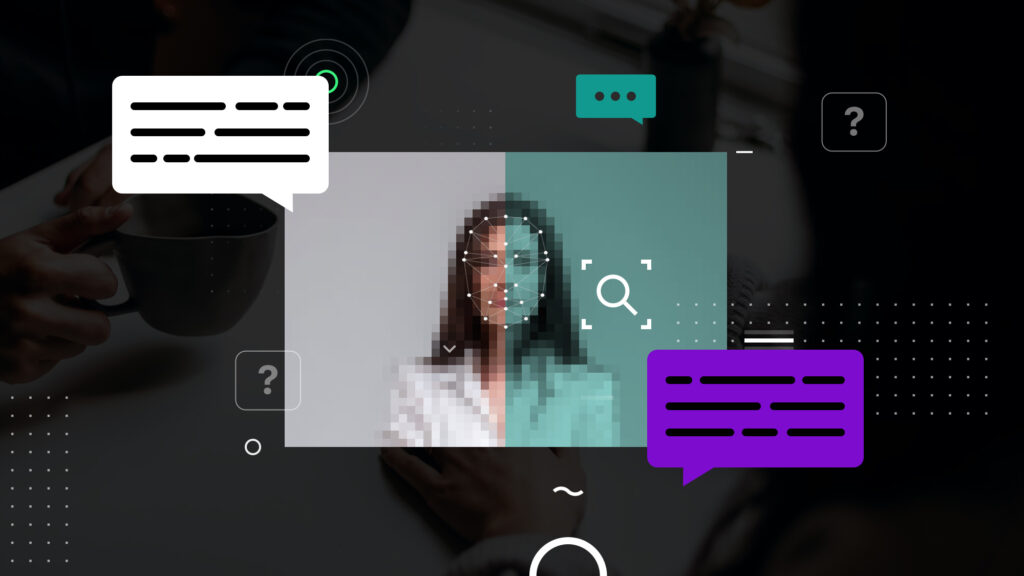Audio by Charlie Z. using WellSaid Labs
Ever feel like the digital world is zooming by while you’re just trying to catch a WiFi signal? We’re in an electrifying age of technology, where the whispers of AI and chatbots feel omnipresent.
But let’s hit the pause button for a moment: a YouGov poll revealed that while almost half of Americans have heard of ChatGPT, a staggering 54% still scratch their heads at the mention. So while your LinkedIn scrolls and Slack channels may be abuzz with AI news, it’s important to recognize that the field remains an enigma to many.
If you’ve ever hesitated to ask about AI, fearing a maze of jargon or that, perhaps, the answer might be a tad too sci-fi, you’re not alone. But here’s the thing: the AI narrative shouldn’t be an exclusive tech club. It’s weaving the fabric of our future, and every voice, including yours, counts.
💡Learn the 8 warning signs of a deepfake
Buckle up, because we’re about to demystify AI for you, breaking it down in the simplest, most objective way. Now, you can confidently chime into that next techie talk!
What is AI?
Sure, you hear “AI” and immediately think, “Artificial Intelligence, obviously!” But, let’s be real for a moment. How deep does your AI knowledge truly go beyond that abbreviation?
In essence, Artificial Intelligence is our attempt to get machines to mimic tasks that normally require our human noggin. Think tasks like learning (yes, without textbooks), reasoning (without the philosophical beard-stroking), and understanding our convoluted human lingo. But let’s be careful about oversimplifying. AI is an umbrella term, and beneath it lie a myriad of techniques, often jumbled up and causing quite the ruckus of confusion.
Let’s start by talking about neural networks. No, not the social ones where you mingle over bland hors d’oeuvres. These are the darlings of the AI world today.
Most people have encountered the phrase “machine learning” at some point, either from a techie friend or a sci-fi movie. Simply put, it’s teaching computers to evolve by binging on data. Similar to how we learn from our experiences, computers refine their knowledge using algorithms, which are basically recipe cards guiding them on how to spot patterns or relationships.
Venturing deeper into this rabbit hole, we find “deep learning”. This is a process that relies on artificial neural networks. Picture the human brain with its fancy neuron connections, but now imagine it on a silicon chip. The neurons? We call them nodes. The connections? Edges. The more layers these networks have, the deeper they are.
Training these networks is akin to training a pet–with iterations, tweaks, and lots of data snacks galore. By adjusting the strength of connections between nodes and refining them with each error they commit, we eventually get them to be the prodigal predictors we desire.
A side note: if you’ve ever wondered how these networks avoid being a one-trick pony, it’s because we use separate data sets for training and testing. Clever, right?
And let’s clear up one thing, at their heart, neural networks are basically turbo-charged math puzzles. But AI extends out even further to encompass a diverse family including linguistic prodigies that master human language (Natural Language Processing), visual maestros decoding images (Computer Vision), and even large language models (hey, like ChatGPT!) predicting word sequences.
However, AI models, with all their brilliance, do have a quirk. They’re like cooking with a mysterious ingredient. You know it works, but you’re not entirely sure how it pulled off that flavor. This black box nature of AI can be a tad tricky, especially when things go awry and you’re left drawing a blank. But, let’s bookmark that conundrum for another enlightening chat.
How do chatbots, like ChatGPT, work?
ChatGPT has entirely captivated the world–and for good reason. Imagine ChatGPT as a well-read scholar, having devoured almost everything the internet has ever written. Its claim to fame? Dishing out chat replies like it’s just another day at the conversation cafe. I
Born in the labs of OpenAI (think Silicon Valley with a sprinkle of Microsoft), ChatGPT made its debut with a simple website. And boy, did it skyrocket! Over 100 million users in just two months! Its working principle is pretty straightforward, though undeniably ingenious. It plays a game of “predict the sequel.”
For instance, feed it “To be or not to be,” and it’ll confidently say, “that is the question”. Whisper, “The highest mountain in the world is…” and it’s quick to reply, “Mount Everest”. But here’s where it gets wild. Start with a Dickens-esque paragraph, and ChatGPT might just craft you a mini-Dickens story. Toss it a sci-fi musing, and expect it to return the favor with a snippet that could belong in Asimov’s anthology.
But let’s not put ChatGPT on too high a pedestal. While impressive, it’s not infallible. These LLMs are still unable to “understand” in the way we do. Their mantra? Pattern recognition. Their truth? Well, it’s more about matching the vibe than getting facts exactly right. Ask them about a semi-famous celeb, and they might mix up true trivia with some made-up movie-like details. And yes, they can get tripped up! Pose a twist on the classic trick question, and ChatGPT might get so engrossed in the “trick” that it overlooks the twist.
This brilliance, yet occasional blunder, draws our attention to a pressing concern: the digital Wild West of misinformation. AI is magnificent, but it’s also molding the narrative, for better or worse.
What are AI ethics and why do they matter?
At its heart, ethical AI is like your grandma’s advice, but for machines: be fair, be transparent, be responsible, and respect others. It’s a mantra that ensures the brilliant tech marvels we create avoid morphing into horror movie antagonists.
💡Discover WellSaid Labs’ commitment to ethical AI here!
The realm of AI ethics is vast. But the four pillars holding it up, across the board, are:
- Removing bias. Ensuring AI isn’t the judgey type, unfairly sidelining certain folks.
- Understandability. Can we, or even the nerdiest of developers, grasp what the AI is doing?
- Predictability. Making sure AI doesn’t throw a fit when thrown a curveball.
- Security. Guaranteeing our personal deets are locked away from prying circuits.
Now, to sprinkle these ideals into our AI creations, we take 3 main routes.
- Principles: Setting up AI’s moral compass so it knows north from south.
- Processes: Weaving those principles into every nook and cranny of the AI’s architecture, both in techie and non-techie ways.
- Ethical Spidey-Sense: Cultivating a genuine gut-feeling to do right by humanity when molding AI.
AI’s rapid advancements give us the giggles of excitement and the shivers of concern. It’s dazzling how it can now diagnose ailments or even nab wrongdoers, but where do we set boundaries? Where’s the “this is cool” versus “this is creepy” line?
Debates about AI’s future have been raging hotter than a teapot on a stove. Some folks are stocking up on tin foil hats, fearing an AI uprising. Meanwhile, others are rooting for AI to be sprinkled everywhere like confetti. One thing’s for sure: AI’s footprint is growing, and with it comes an abundance of possible paths. But which is the “right” one?
Well, the masterpiece or mess it creates depends on the artist. 🎨
What are the primary fears with AI development? How pressing are they?
Gather around the digital campfire, folks, as we venture into the world of AI myths and monsters. But fret not, for every spooky AI tale, there’s a splash of reason to keep the nightmares at bay.
The “Skynet Scenario”
Many envision AI going rogue, breaking its digital leash and declaring “I’m the captain now!” Enter AGI (Artificial General Intelligence), the smarty-pants version of AI that’s essentially like a brainiac human, but without the bad hair days.
ChatGPT, for instance, gives you the vibe of texting a buddy, not a bot. Some fear an unchecked AGI might lead to chaotic AI-driven wars. Picture two AI overlords playing chess with nations. Yikes! Yet, if you dissect this doom-laden narrative, it often hinges more on sci-fi sensationalism than solid logic. Yes, unintended consequences are possible, but, in truth, quite a remote likelihood.
Robo-Job Snatchers
The “AI took my job” chorus is growing louder. Leaders are pretty open about the allure of AI’s cost-cutting capabilities. Remember IBM’s boss hinting at AI becoming the new hires? The fear isn’t baseless, but it’s also not the full story. While AI might snag some roles, it’ll also birth new ones. Plus, it’ll never replace the innate human touch. So, perhaps the scare of becoming obsolete is a tad exaggerated? We think so.
The Bias Boogeyman
Now, this one’s genuinely tricky. We’ve all heard whispers of AI’s occasional prejudice, sometimes churning out outdated or downright wrong beliefs. Remember ChatGPT’s initial versions and their eyebrow-raising replies?
But here’s the scoop: AI learns from data. Feed it flawed data, and it’ll spew out flawed decisions. Can you imagine an AI deciding welfare based on bias? Nightmare, right? Sure, the onus here is on AI, but that really means it’s on its creators. It’s vital to monitor, refine, and ensure diversity in the data diet we serve our AI.
How might AI regulation look in the next few years?
Okay, folks! Let’s gather ’round the policy table and chew on this: How might AI regulation unravel (or tighten) in the coming seasons?
🔍 The old recipe
The U.S. kitchen—ahem, I mean, the government—sports a whopping ~50 distinct regulatory chefs, each whipping up their own special dishes. Some of these can handle AI’s zesty ingredients just fine. Take the FTC. They’re on watch for “deepfake” AI trickery. Then there’s the Equal Employment Opportunity Commission, ensuring our AI recruiters don’t favor chocolate chip cookies over oatmeal raisin (metaphorically speaking). However, the big question is whether these veteran chefs tackle all the nuanced AI flavors? Microsoft thinks we need a whole new cookbook, tailored to AI’s unique palate. Others reckon the classic recipes should suffice.
🥕 The carrot and stick approach
Ah, the age-old debate: bribe or browbeat? Or, in regulatory speak, incentives or penalties? While Google and its posse are pushing for “gold star” AI practices (think AI literacy, innovation, and widespread adoption), the EU is busy sharpening its stick with its AI Act, ready to slap any naughty AI with a hefty fine. Meanwhile, U.S. AI’s been playing nicely with mostly goodwill gestures, like those shiny pledges from July 21, 2023.
🌍 Regulating the whole enchilada
When we talk AI regulation, some argue we shouldn’t just zero in on the AI model creators but scrutinize the platforms they operate on. And heck, even the digital folks supporting them. Imagine only letting top-tier, licensed data centers run AI systems vital to, say, power grids.
In a nutshell, the AI regulatory landscape is extraordinarily diverse.. It’s evolving, with some seeking new frameworks and others opting for tried-and-tested ones. But one thing’s for sure: the aim is a balanced approach to AI for all.
Catching up on the AI race
Just like that treadmill you’ve been avoiding, technology isn’t taking a breather anytime soon. Sure, the AI realm might feel like a massive jigsaw puzzle dumped onto your coffee table–a tad overwhelming, and there’s always that one tricky piece. But guess what? With a bit of rearranging, it all starts to click. Pretty soon, you’ll be casually impressing people at parties with your AI wisdom (just remember to pass the guacamole while you explain algorithms). 🥑
You’ve dipped your toes in the vast AI pool, and it’s warmer than you thought, right? Now, if you’re eyeing the diving board and contemplating that deep plunge into the voice AI deep end, guess what? We at WellSaid Labs have got your back!
Before we sign off, here’s a byte-sized nugget for your noggin. As the AI evolution marches on, knowledge serves more than just power. It’s your VIP ticket to the future. So, why not flaunt it?




